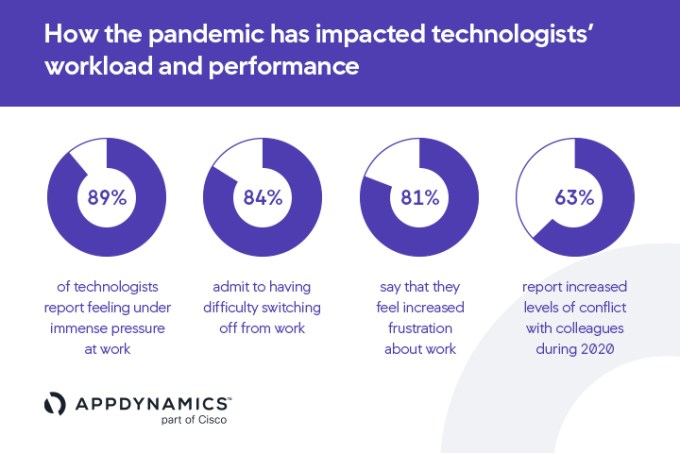By Ty Amell, CTO, AppDynamics
It’s hard to imagine how much can — and has — changed in a span of 12 months. Roughly one year ago, many of us were forced to shift our lifestyle overnight as lockdowns and precautions for COVID-19 became prevalent and organizations had to rapidly adapt to this new way of work and conducting business. As companies were forced to make the jump to fully remote work in the blink of an eye, the reality was that digital transformation projects accelerated at a rapid pace for technologists — on average, three times faster than any previous year, according to the recently released Agents of Transformation Report from AppDynamics.
Pandemic drives IT to boiling point
With digital projects ramping up at such an accelerated pace, the absolute necessity to digitally transform created intense pressures and complexity for teams. Think about it — when you open an app, and it doesn’t load or it crashes, do you try again or just move on? It’s proven that many of us would find another way to get to the information. With a seamless digital experience taking center stage as the world transitioned to virtual life, the risk of losing customers and damaging an organization’s representation was, and continues to be, too great for many companies to bear.

Image Credits: AppDynamics (opens in a new window)
In a year of unprecedented situations, it’s no surprise that an overwhelming 89% of technologists reported feeling immense pressure at work in 2020, acknowledging that the response to the pandemic has created more complexity than they’ve ever experienced before. As we hit the one-year mark of this pandemic, it is abundantly clear that teams have reached their absolute boiling point as they worked tirelessly to adjust to and manage these new demands fast. The urgent innovation and technology sprawl has stretched teams thin and added an extra layer of complexity to their work. How do fried and frazzled teams make sense of the overwhelming amount of data they encounter on the job?
Navigating the flood of data
In addition to navigating new complexities, the pace of change within these organizations is expected to continue accelerating over the next year, as businesses look to build upon new technology innovations in order to grow and thrive in a turbulent marketplace. Roughly 88% of technologists surveyed predict that continuing to drive this type of transformation at speed will be their biggest challenge for the year ahead and the years to come. So, how do they plan to stay ahead of the curve and navigate the amount of data that is incoming every second?
Technologists have recognized the acute need for full-stack observability which is the ability to monitor their systems from the bottom up — from traditional systems to new, hybrid cloud environments. Full-stack observability gives technologists the ability to blend the ability to observe and monitor their entire stack, from customer-facing applications down to core network and infrastructure. It enables technologists to identify and fix performance issues before they adversely affect customers and the business and provide a seamless digital experience. However, full-stack observability alone, while a game-changer, is not enough to combat the staggering complexity and data now facing technologists on a daily basis.
In order to not only tackle the new complexities and cut through the noise brought on by the pandemic, it will be imperative for technologists to take critical next steps to align observability with business performance. By doing so, they’ll be able to observe and understand how the business is impacted, and be able to quickly prioritize actions, innovations and investments that tie directly back to customers and the business.
Bringing business context to full-stack observability

Image Credits: Getty Images
By applying a business lens to full-stack observability, technologists can observe what matters most to the business and retrieve the impactful information quickly to take transformative action. In doing this, technologists turn their application performance into business profit.
In the next 12 months, three quarters of technologists agree that their organization needs to effectively connect full-stack observability to business outcomes to remain not only successful, but competitive. However, over half (66%) claim to lack the strategy and tools to effectively measure how those decisions impact outcomes.
It’s clear the inability to connect technology performance to business outcomes can be detrimental to organizations. Technologists need to solve issues they are encountering within their organizations to make that happen. According to our research, technologists have a lack of skills within their department, which creates a business case for investment and potential integration obstacles as the biggest issues standing in their way of being able to adopt a successful full-stack observability solution.
The year ahead
In what was truly a year of uncertainty, technologists rose to the challenge to provide customers with experiences and kept us all online. While the months were ever challenging and testing, the heightened spotlight on applications has brought endless opportunities and insights to continually improve customer experiences – and the bottom line for organizations.
Nearly every response in AppDynamics’ Agents of Transformation Report (96%) indicated that the ability to monitor all technical areas across an organization’s technology stack and directly link that performance to business outcomes was absolutely essential to delivering first-class digital experiences and continuing to accelerate digital transformation. And while the year ahead looks to be equally difficult to grow at scale as demand continues to land on teams, full-stack observability tied to business context has the potential to empower technologists in this defining moment and increase their performance.
This continues to be a defining moment for technologists to deliver the innovation that organizations – and our wider economies – will need to recover and prosper in the months and years ahead. It is evident that businesses can no longer afford to be blind to the impact of technology performance on customer experience and the business.
AppDynamics, part of Cisco, is committed to helping technologists as they continue to lead their organization’s responses to the pandemic in an ever changing and complex environment, providing the technology, support and training they need to practice. You can learn more about the AppDynamics Business Observability platform here.